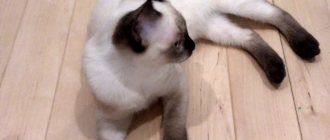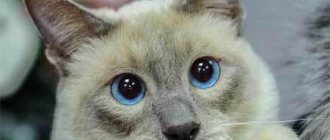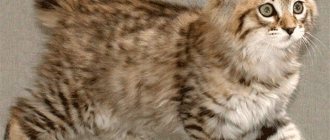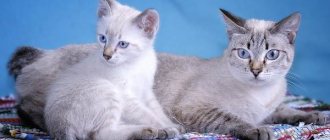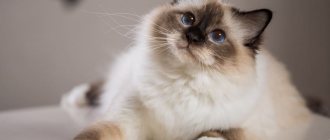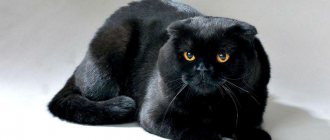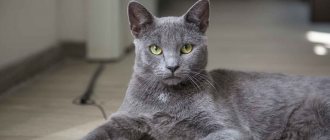The Japanese Bobtail cat shown in the photo is very rare in Russia, but in Asia it has been revered since ancient times. Residents of the Land of the Rising Sun believe that it brings good luck. Among other things, animals are valued for their friendliness, playfulness, high intelligence and loyalty. What are the features of this breed, what are its disadvantages and how to care for a short-tailed pet, read on.
Japanese Bobtail
Origin story
Scientists suggest that the ancestors of Japanese bobtails sailed to Japan on merchant ships from China about 1,000 years ago. In those distant times, they still had tails of standard length. The four-legged settlers lost this part of their body due to the superstitions of the local residents.
According to the official version, the animals were domesticated by Emperor Ichijo. His first pet was named Myob-no-Otodo. She was loved by the ruler and could move freely around the palace. Ordinary residents avoided long-tailed cats. They believed in the legend of a dark cat who finds unseemly people and brings misfortune to them through other cats. The Japanese sincerely believed that negative energy was concentrated in the tails of animals, so they began to shorten them.
This continued for several centuries and eventually led to mutation. Kittens with very short or crooked tails began to be born in litters. Such pets did not frighten local residents; they were believed to bring good luck. Then the doors of Japanese homes opened for tailless cats, and they became desirable pets.
At the beginning of the 17th century there was a rat infestation in Japan. Rodents destroyed food supplies and spread dangerous diseases. Then the emperor called on all residents of the country to release their pets onto the city streets so that they could help get rid of the rats. Thanks to this, bobtails were able to reproduce unhindered, their population increased greatly, and their genes were fixed. The export of cats from the country was strictly prohibited at that time.
The modern history of the Japanese Bobtail began in 1967–1968, when traders exported several individuals to Western Asia and then to America. A little later, Abyssinian cat breeder Elizabeth Freret, an American, bought 3 short-tailed pets during a visit to Japan and brought them home. The breed was standardized and registered in 1976.
The longhaired bobtail variety was only recognized in 1991. Previously, fluffy kittens were culled, but then it turned out that the Japanese emperor bred both short-haired and long-haired pets at his court. Having learned about this, the breeders insisted that felinological organizations recognize the second variety of Japanese women.
Coloring Features
The Japanese Bobtail is distinguished by a faded color compared to the same Thai Bobtail, which has a contrasting coat. But cats of bright colors are also found in this breed, although less often. They are considered the most valuable. There are several color options:
- tricolor or mi-kay;
- fiery red;
- snow-white;
- black.
The eyes of a cat most often have a slight yellow tint, while in an animal with a white color they are blue. But sometimes animals are born with different colored eyes. This is especially true for snow-white kittens.
This variety is always worth higher than the standard options, because such an individual will always produce kittens with different eyes.
Photo of Japanese Bobtail cat and description of the breed
This is a medium-sized animal with a well-developed muscular corset and a short, raised tail resembling a pom-pom. The weight of males varies between 5–7 kg, females – 3.8–5 kg.
Exterior:
- the head is medium, has the shape of an equilateral triangle with well-defined high cheekbones and convex rounded cheeks;
- the bridge of the nose is elongated, wide, with a neat nose; a shallow stop is visible in profile;
- large oval eyes with slightly raised outer corners;
- the color of the iris depends on the color and can be yellow, blue, orange, green, there are also individuals with different eye colors;
- ears slightly larger than average, set high and wide, with rounded tips;
- the neck is short or medium length, dense, strong, smoothly turning into a powerful chest;
- the body is compact but muscular, the back is straight;
- the length of the limbs is proportional to the body, the paws are strong;
- the tail can have a different shape, but its length should not exceed 7–8 cm;
- the coat is devoid of undercoat and can be short or long, soft to the touch, silky with a beautiful glossy sheen;
- the standard provides for a wide variety of colors - plain, bicolor, tri-color, tortoiseshell; the mi-ke variant, in which there are red and black spots on a white background, is especially popular.
Attention! Each cat has an original tail shape - straight, curled, spiral or curved tails can be found.
Deficiencies and vices leading to disqualification
The main reason why bobtails are not allowed to participate in exhibitions and breeding production is due to various tail defects. For example, if it is too long, not pubescent enough, does not resemble a pompom, or is completely absent. Also a reason for disqualification is the so-called pushed back bobtail, when the squiggle is more than 2.5 cm from the beginning of the tail.
Japanese Bobtail cat breed
Exterior disadvantages include:
- too heavy frame;
- round head shape;
- squatness.
Breed characteristics
COUNTRY OF ORIGIN
Japan
EXTERIOR
Elegant sporting cats, slender but muscular, with long legs, the hind legs are powerful and longer than the front. Triangular head with high, defined cheekbones. The eyes are set slightly at an angle. Large vertical ears are set high. The eye color is in harmony with the coat color. Eyes can be different colors. The tail is clearly visible and covered with long hairs, giving the appearance of a pompom.
SIZE
Average
COLOR
Cats of the short-haired variety have a soft, silky coat of medium length, while long-haired cats have a longer and noticeable undercoat. The colors are varied.
PECULIARITIES
Curious, active, lively, playful, affectionate cat.
Character and interaction with a person
The Japanese bobtail cat will never let the members of the family in which it is raised get bored. This is a real tsunami, a bundle of energy with a pretty face. Animals exhibit high physical activity at any age. They never sit still - the pet constantly explores the house, climbs into the most unexpected places, catches flies, chases a ball, and jumps. When returning from work, do not be surprised by upside-down interior items - your pet was entertaining himself as best he could.
Representatives of this line love to talk. Be prepared to listen to cats talk about everything every day. The pet will tell you in a low, hoarse but quiet voice how his day went, how much he missed him, how hungry he was. The Japanese “energizer” subtly senses a person’s mood and knows how to adapt to the intonation of the voice. Owners of short-tailed cats say that they easily reproduce the sounds that their owner makes.
Each cat has a unique tail shape and length
Due to the highly developed instinct of the hunter, the Asian cat should not be kept together with small rodents or birds. But they get along easily with dogs - they sleep, eat together, and run after the ball. In general, it’s good if there is more than one pet in the house. Such an active cat simply needs a friend. If there are no other animals in the apartment, get a pair for a bobtail. By the way, natives of Japan are not jealous; they will not fight with each other due to a lack of master’s attention.
The attitude towards children is friendly. The pet will be happy to play together, provided that the baby does not hurt him. The most sensitive place on a bobtail's body is the tail. Even a light touch to it causes unpleasant sensations, not to mention a careless poke. Warn your child about this, do not allow him to grab the cat by the tail. Otherwise, the pet will avoid him.
High intelligence and quick wits will help your four-legged friend achieve success in performing simple tricks. True, Japanese bobtails are stubborn, so they will have to be trained in a playful way, not forgetting to motivate and encourage them with treats. The easiest way for cats is to jump over obstacles and execute the “Fetch” command.
Education and training
On the one hand, Japanese bobtails are stubborn, no matter what. On the other hand, they are terribly smart and reach unprecedented heights in training. So, if you want to teach your cat a few tricks, seize the right moment when the pet is in a good mood. If you manage to arouse the purr’s interest and intrigue him with his activities, consider the most difficult part of the work done.
As for the selection of exercises, most of all Japanese Bobtails like to fetch rubber toys, catch an imaginary fly on command and do a stand on their hind legs. Jumping through a gymnastic hoop or barrier is easy for the breed. Since in their free time cats often “fly” from the closet to the sofa and back, practicing this skill on any sports equipment, including the same hula hoop, will not be difficult.
On the street, Japanese bobtails are walked almost like dogs, that is, on a harness. True, provided that you introduced the cat to this item in advance. Usually, in order to accustom a “Japanese” to walking on a leash, a traditional technique common to all cat breeds is sufficient. First, show your pet the harness and let him smell it. Then leave the strap near the cat's bed so that the animal gets used to it. At first, wear the harness at home and only for a few minutes. If the Japanese Bobtail shows suspicion and does not want to get into the collar, you can appease it with a piece of some yummy food.
Maintenance and care of the Japanese Bobtail
Before a kitten appears in the apartment, you need to prepare for this - install screens on the windows, hide wires and carriers, remove fragile interior items.
Caring for a Japanese Bobtail is easy
Buy equipment and pet care products in advance:
- tray;
- filler;
- carrying;
- bed;
- harness;
- food bowls;
- furminator or massage mitten;
- a lot of toys;
- cat complex (if there is free space in the house);
- scratching post;
- shampoo;
- toothpaste and brush for animals.
Hygiene
Caring for the shorthaired Japanese Bobtail is not burdensome. It is enough to comb it once every 5-7 days, and more often during shedding. Monitor the condition of your ears - remove greasy deposits from the external auditory canal. Shorten the nails once every 2 weeks by 1–2 mm. Pay special attention to your teeth - they should be brushed 4-5 times a month with a special paste for animals.
Representatives of the Japanese Bobtail breed love water, but since their coat is water-repellent, washing the pet is not so easy. Most of the time is spent getting it wet. After bathing, pat dry thoroughly with a soft towel and dry with a hairdryer, directing the flow of warm air along the hair growth.
Ears are cleaned once a week
Caring for a pet also includes taking care of its health. Once a year, animals need to be vaccinated against infectious diseases - rabies, calcivirosis, chlamydia and panleukopenia (distemper). Deworming is recommended twice a year. To prevent infection with skin parasites, use a collar or drops on the withers.
Due to high physical activity, walking is useful for Asians. It is better to take your pet out on a leash. From childhood, accustom him to a harness. Do not leave your cat outside unattended - curiosity can play a cruel joke on it.
Dietary advice
Japanese short-tailed cats are unpretentious and will eat anything, but for health and beauty they need a balanced diet. Veterinarians advise feeding them super-premium or premium commercial dry kibble.
Many breeders create their own menus for their pets using homemade products. It is important to adhere to the 80x20 rule, where the main part of the diet is poultry, veal, beef and rabbit. About 20% of the total food a cat receives is supplements in the form of cereals, vegetables, fish, eggs and dairy products.
Feeding the cat
Energetic and active Japanese people need a balanced diet that contains all the necessary vitamins and minerals.
Complete diet
Many breeders prefer to feed Japanese bobtails with premium or super premium dry food. It is good because it already contains all the necessary vitamins and microelements. The main thing is that it does not contain wheat, soy, dyes or other dubious additives. The following brands of food are optimally suited to these requirements:
- Hills;
- Arden Grange;
- Brit Care;
- Bosch.
With a natural type of nutrition, the diet of the Japanese Bobtail is designed so that meat predominates in it. The cat should also receive:
- porridge;
- offal;
- vegetables;
- eggs;
- sour milk;
- ocean fish.
To avoid problems with the digestive system and health in general, the Japanese Bobtail should not be given sweets, pickles, smoked foods, sausages, pork and starchy vegetables. It is also forbidden to feed the cat river fish, fresh milk, exotic fruits and any leftovers from the owner’s table.
Feeding frequency
Little Japanese eat less, but more often than adult representatives of the breed. Therefore, when drawing up a feeding schedule, you need to focus on the age of the cat:
- up to 16 weeks – 6 times a day;
- 4-5 months – 5 times a day;
- 5-9 months – 4 times a day;
- 9-12 months – 3 times a day.
A one-year-old Japanese bobtail is fed twice a day.
Vitamins and minerals
When feeding natural products, a cat’s body may lack certain microelements. To compensate for this deficiency, the Japanese Bobtail is given vitamin complexes twice a year in courses.
Important! Before introducing mineral supplements into the Japanese diet, you should consult a veterinarian.
Nuances of breeding
Breeding Japanese bobtails is quite difficult, since the breed is not widespread in Russia. It is very difficult to find a partner for mating, because crossing these animals with representatives of other breed lines is prohibited.
Japanese Bobtail kittens
Sexual maturity in females occurs at the age of 7–8 months, but they are ready for mating at one and a half years, after 2–3 heats. When choosing a candidate for the role of groom, the first thing to evaluate is his tail. It must meet the requirements of the standard. It is also advisable to study the cat’s pedigree and find out whether he has mating experience. It is very important that the male knows how to care for his bride.
The date always takes place on the territory of the groom. The cat is brought to his house on the 2nd or 3rd day of estrus. For about a day, the pets get to know each other, and then mating games begin. Ideally, if the cat covers the female several times, then the chances of pregnancy will increase.
Attention! Only individuals that meet the standard are allowed for breeding work. All others are castrated or sterilized. The suitable age for the procedure is from 8 months to 1.5 years.
How to choose a kitten
Unlike their Kuril relatives, Japanese bobtails still remain exotic in Russia, and the nurseries that breed them can be counted on the fingers of one hand. For example, for this period of time, only one organization with WCF and CFA registration, as well as an official website on the Internet, is a confident leader - this is the Innosima nursery.
By the way, don’t expect that a Japanese Bobtail will be sold to you right away. Firstly, due to the relative rarity of the breed, kittens have to be reserved long before birth. Secondly, most nurseries prefer to give promising babies to professional breeders and felinologists, leaving individuals with defects in appearance to ordinary buyers.
General rules for choosing a Japanese Bobtail:
- Don’t be surprised by the unusually large dimensions of the kittens. Japanese Bobtails grow and gain weight faster than most of their relatives;
- evaluate the appearance of a potential pet by checking the breed standard. Pay special attention to the tail configuration, which is a defining breed characteristic of Japanese Bobtails;
- do not neglect the opportunity to meet litter producers. This will make it easier to understand what exactly awaits you when your pet reaches full physical maturity;
- veterinary passport, birth certificate of the Japanese Bobtail kitten, pedigrees of its parents - all these documents must be carefully studied during their stay in the nursery.
Pros and cons of the breed
Japanese Bobtail cats are loved for their unusual, bright appearance, intelligence, friendliness and loyalty. Many breeders are captivated by their good health and low maintenance requirements.
The Japanese Bobtail is a beautiful and friendly pet
These animals also have disadvantages:
- excessive activity;
- too sensitive tail;
- excessive curiosity;
- small distribution of the breed.
Interesting Facts
Close relatives of Japanese bobtails live in the Kuril Islands, in the area of Iturup and Sakhalin. Only their popularity increased in the 90s. last century. Cats from this area belong to the Kurilian Bobtail breed.
They have long hair and also a strange tail shape. A fur coat of wool reliably protects from the cold, and on the front paws there are even downy “pants” that cats inherited from their Siberian ancestors.
Nurseries and prices for kittens in Russia
There is only one official Japanese Bobtail nursery in our country. It is located in the city of Zavidovo, in the Moscow region. In Ukraine and Belarus there are no breeders who breed cats of this breed.
Prices for kittens start from 30,000 rubles. The cost depends on the kitten's pedigree, parents' titles, gender of the animal and color. The price for breeding breeders can reach 150,000 rubles, but in Russia it is unlikely that you will be able to buy a breed- or show-class pet.
Price
The popularity of the amazing Snoopy breed was influenced by two factors:
From private hands, a Snoopy kitten can be purchased for 10–15 thousand rubles. And the cost of a cat in a reputable nursery can rise several times higher, but professional breeders also give guarantees of healthy offspring with confidence. In addition, they provide consulting assistance and are always ready to give advice, which is important for beginners.
It is noteworthy that it was with the appearance of the Chinese cat Snoopy on Instagram that breeding drew attention to the red and white Van color. Many pet lovers strive to acquire just such a pet, and their desires have given rise to a trend for popular coloring.
Owner reviews
The few happy owners of the Japanese Bobtail speak of their animals as smart, energetic and loyal cats that are not characterized by aggression. Representatives of this breed choose one family member as an object of adoration. They are also friendly towards others, but pay less attention to them. Cats are patient with children and do not let out their claws, but they can ignore and avoid babies if they are too persistent in showing love.
Undoubtedly, this breed is worthy of attention, because it was bred naturally, and its representatives have gone through a long and difficult path of development. They had to endure hunger, survive on the streets, and face rejection from superstitious people. All this hardened the animals, made them strong, strong, fast and dexterous.
Castration and sterilization
To preserve the characteristics of the breed, only those animals that strictly comply with all exterior standards are allowed for breeding. All others must be spayed or neutered to prevent unwanted matings. Recommended age range for spaying or neutering
- Cats - after 10 months of age;
- Cats between 8 and 12 months of age (preferably surgery before two years of age).
These operations can be performed from three months of age until old age. However, early spaying or castration can cause delays in the growth and development of the animal. And the older the dog, the more difficult it is to tolerate surgery and anesthesia.
Caring for your pet after surgery
Caring for an animal after surgery is not difficult. The following conditions must be met:
- To prevent the cat from licking the seams, put a special cover or collar on it;
- Once a day, remove the cover and disinfect the seams using disinfectants (chlorhexidine solution, hydrogen peroxide, etc.).
- Limit the animal's activity for several days (to prevent the sutures from spreading);
- Do not feed for 8-10 hours;
- Avoid unnecessary noise and stress;
- If the cat is restless and you see that she is in pain, give her an anesthetic (Ketofen, Pervicox and others), but only a veterinarian can prescribe the dose.
Place a post-surgery collar or blanket on your cat to prevent her from licking the stitches.
Contact your veterinarian immediately if you notice any unusual or suspicious symptoms, such as your cat not eating for more than three days or the sutures becoming swollen or moist.
